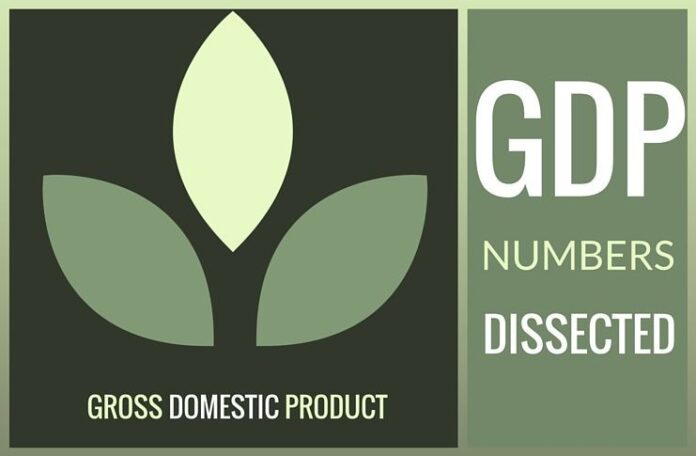
GDP (Gross Domestic Product) as derived is dissected…
This is Part 2 of our series on GDP. For Part 1, click here.
[dropcap color=”#008040″ boxed=”yes” boxed_radius=”8px” class=”” id=””]I[/dropcap]ndia’s economic growth for the financial year 2016 has been estimated at 7.6 per cent as compared with the revised estimate of 7.2 per cent in the previous year, aided mostly by growth in the manufacturing sector. However, the GDP growth for the third quarter of this financial year slowed to a four-quarter low at 7.3 per cent. In the second quarter, it had grown by 7.7 per cent.
The optimism is at odds with weak exports, railway freight, cement production, investment and flat order books that pointed to weakness in the economy. In nominal terms, however, GDP would grow just 8.6 per cent in the current financial year, which would make the fiscal consolidation exercise of the government a great challenge.
Also the surprise is about the spurt in manufacturing both in the 3rd quarter as well as 2015-16 which is not reflected in the index of Industrial production (IIP) which grew only 3.9% in April to November—Somewhere something is amiss!
More important is the increasing skepticism about GDP numbers. Even RBI Governor has voiced his concern and of course like a good bureaucrat, he retracted it later.
[dropcap color=”#008040″ boxed=”yes” boxed_radius=”8px” class=”” id=””]T[/dropcap]he important point is about the GDP numbers based on new base year of 2011-12 and its reliability. Also the Central Statistical Organisation (CSO) has given up the earlier system of organised and un-organised sector. Instead they have household and Non-profit institutions serving households [NPISH] following G-7 style.
The major differences between old series with base year as 2004-05 and new series as 2011-12 are
-
GDP at factor cost is now passé and will not even be mentioned by the government in future statements. GDP at market prices was recorded in the past as well even though it was not counted while calculating economic growth. In place of GDP at factor cost, gross value added (GVA) at basic prices will be used now.
The difference between GDP at factor cost and GVA at basic prices is that production taxes are included and production subsidies excluded from the latter.
Production taxes and subsidies are different from product taxes and subsidies.
[dropcap color=”#008040″ boxed=”yes” boxed_radius=”8px” class=”” id=””]T[/dropcap]hese (production taxes) are imposed even if the products are not produced, such as property tax. However, excise duty, value added tax etc. are all product taxes. Similarly, product subsidies would not include interest subsidies, which will form part of production subsidies. Now, GDP at market prices would come by adding product taxes and deducting product subsidies from GVA at basic prices.
GVA at factor cost rose 4.9 per cent in 2012-13 and 6.6 per cent in 2013-14. The net result was that GDP at market prices rose 5.1 per cent in 2012-13 and 6.9 per cent in 2013-14.
Within GDP as well, composition of various sectors have changed. For instance, the share of manufacturing rose from 12.9 per cent in the old base to 18 per cent in the new series for 2013-14. The government wants to increase the share from 18 per cent to 25 per cent in a decade. This was because certain services that go into after product moves out of factory are included in the manufacturing.
Two kinds of approaches — establishment and enterprises — are used in calculating manufacturing production. Till now, only establishment approach was used which means calculating production plant by plant. On the other hand, in enterprises approach the activities at headquarters are taken into account. For instance, after an item is produced, various marketing and sales promotion efforts go at headquarters level. In accounting parlance it is looking at operating surplus [only from manufacturing] and surplus after taking into account head office expenses and sales and marketing expenses.
In the new GDP data, establishment approach is used for small companies as they have a few plants or sometimes a single plant. But, for large corporate, enterprises approach is used. -
The category of organised and unorganised is discontinued. There is no statement 76.1—which contained the separate share of organised and unorganised sector in NAS 2015 as was the case in NAS 2014.
This is a major change and requires substantial explanation. In the earlier situation the share of unorganised sector was:
-
Most of Agriculture-95%; nearly 30% in manufacturing; 78% in Trade/ Hotels and restaurants and 80% in Non-Railway transport. All are at 2012-13 Gross value added or GDP at factor cost at current prices.
-
Now CSO has “abolished” unorganised sector in their statistics but not in the real economy.
-
This “unorganised sector” is now included in Household sector and NPISH (Non-Profit institutions Serving Households).
-
More fascinating is the inclusion of unincorporated enterprises – maintaining accounts is included under private non-financial corporate sector.
[dropcap color=”#008040″ boxed=”yes” boxed_radius=”8px” class=”” id=””]H[/dropcap]ow unincorporated can be part of Corporate is a CSO mystery. More than that “unorganised Financial enterprises” is also included under private financial corporations.[ p7; changes in Methodology and Data sources in The New series of National accounts –Base year 2011-12 –CSO;MOSPI]
Does it imply money lenders near my market are included as part of a private corporate entity?
Due to all these – estimates of GVA at current prices 2011-12 [at factor cost for old series and base prices for new series] varies significantly [of course a caveat is given that they are not strictly comparable].
In manufacturing it shows a 20% positive difference from Rs.12 lakh crore ($175 billion) to Rs.15 lakh crores($218 billion); in trade/hotels and restaurants a reduction of 40% from Rs 15 Lakh ($215 billion) to Rs 9 lakh crore ($131 billion) and in other services a reduction of 20 % from Rs.7 lakhs ($102 billion) to Rs.5 lakhs crore ($72.8 billion).
Statement 9 in the press release of Ministry of Statistics and Programme Implementation (MoSPI), dated 30.1.2015 or Statement 1.14 in NAS 2015 (both are available on the website of MoSPI) presents institutional sector-wise GVA in the economy. From this statement it is possible to work out share of organized and unorganized sector with limitation that estimates of quasi-corporates not being available separately in the new series for 2011-12 to 2013-14. The share of unorganised sector which is household and NPISHs in 2011-12 series for the year 2011-12 at current price is 44.9%. The share of unorganised which included household and unorganised enterprises for the year 2011-12 in 2004-05 series was 56.1%.This difference is due to inclusion of quasi corporates in the corporate sector and also due to use of latest data from NSS 67th round on unincorporated sector. -
In short massive amount of the unorganised sector is shifted as “corporate” under quasi corporate definition.
To be continued…
Note:
1. The conversion rate used in this article is 1 USD = 68.73 Rupees.
2. Text in Blue points to additional data on the topic.
- नकली खबर लक्षण है, बीमारी नहीं! - April 16, 2018
- Fake News/ Accreditation and Sedition - April 4, 2018
- Two Poisonous Seeds - March 15, 2018










